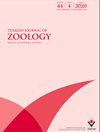Discovering underground bat hibernacula in lowland eastern Europe
IF 1.7
4区 生物学
Q2 ZOOLOGY
引用次数: 0
Abstract
: The importance of underground hibernacula for the conservation of bats and monitoring their populations is well-recognized. However, the lowland territory of Belarus, with absent natural caves and suitable for bats mines, was one of the least surveyed European regions in terms of underground bat sites, and especially hibernacula. To address this knowledge gap, in 2020, we conducted a broad-scale one winter bat survey, exploring 90 underground sites (basements, cellars, church crypts, fortifications, and facilities of abandoned Soviet missile bases) in various parts of Belarus. To our knowledge, none of these sites had been examined for bats before. In 56 of the 90 underground sites, we discovered hibernating bats (a total of 1054 ind.) of six species: Barbastella barbastellus (78.5% of all bats), Myotis daubentonii (7.4%), Plecotus auritus (5.1%), Eptesicus nilssonii (4.9%), Myotis brandtii and Eptesicus serotinus (in sum, 2%). The distribution of bats among the hibernacula was highly uneven (with N Me = 3; N av = 19 ind.). In 76% of the hibernacula, the number of bats was between 1 and 10 individuals per site, which accounted for approximately 10% of all bats recorded during the survey. Only in five sites we found over 50 bats. One to four species were present in each site, with one species found in 58% of the hibernacula. We suppose that the small number of species and relatively small number of bats per hibernaculum is characteristic of the study region. This supports the在东欧低地发现地下蝙蝠冬眠地
地下冬眠对保护蝙蝠和监测蝙蝠数量的重要性是公认的。然而,白俄罗斯的低地地区没有天然洞穴,适合蝙蝠采矿,是欧洲调查最少的地下蝙蝠地点之一,特别是冬眠地。为了解决这一知识差距,我们在2020年进行了一次大规模的冬季蝙蝠调查,探索了白俄罗斯各地的90个地下地点(地下室、地窖、教堂地下室、防御工事和废弃的苏联导弹基地设施)。据我们所知,以前没有人在这些地方检测过蝙蝠。在56个地下点中,共发现6种冬眠蝙蝠1054只,分别为Barbastella barbastellus(占总数的78.5%)、Myotis daubentonii(7.4%)、Plecotus auritus(5.1%)、epotis nilssonii(4.9%)、Myotis brandtii和epotis sertinus(合计2%)。蝙蝠在冬眠群中的分布极不均匀(N = 3;N av = 19)。在76%的冬眠地中,每个地点的蝙蝠数量在1到10只之间,约占调查中记录的所有蝙蝠的10%。我们只在5个地点发现了超过50只蝙蝠。每个地点都有一到四个物种,其中一个物种在58%的冬眠中被发现。我们认为,物种数量少,每个冬眠区蝙蝠数量相对较少是研究地区的特征。这支持
本文章由计算机程序翻译,如有差异,请以英文原文为准。
求助全文
约1分钟内获得全文
求助全文
来源期刊

Turkish Journal of Zoology
ZOOLOGY-
CiteScore
2.30
自引率
10.00%
发文量
24
审稿时长
6-12 weeks
期刊介绍:
The Turkish Journal of Zoology is published electronically 6 times a year by the Scientific and Technological Research Council of Turkey (TÜBİTAK).
-Accepts English-language manuscripts in various fields of zoology including systematics, developmental biology, behaviour biology, animal models, molecular biology and molecular phylogeny, genomics, physiology (cell communication and signaling systems), biochemistry and immunohistochemistry, applied parasitology and pathology, nanobiotechnology, ecology, evolution, and paleontology of animal taxa.
-Contribution is open to researchers of all nationalities.
-Short communications are also welcome, such as reports of a preliminary nature or those including new records from specific localities or regions, and the editor reserves the right to decide that a paper be treated as a short communication.
-The papers that deal with purely checklists, new host and non-regional new locality records will not be consider for publication.
-Letters to the editor reflect the opinions of other researchers on the articles published in the journal. The editor may also invite review articles concerning recent developments in particular areas of interest.
 求助内容:
求助内容: 应助结果提醒方式:
应助结果提醒方式:


